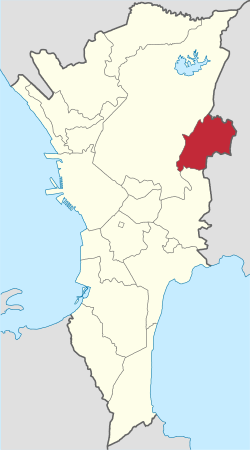
Back ماريكينا Arabic Marikina BCL Marikina CBK-ZAM Marikina CEB Marikina Czech Marikina German Marikina Esperanto Marikina Spanish ماریکینا Persian Marikina Finnish
Marikina | |
|---|---|
| Nickname: Shoe Capital of the Philippines | |
| Motto(s): "Discipline, Good Taste, Excellence" | |
| Anthem: Himno ng Marikina (Marikina Hymn) | |
 Map of Metro Manila with Marikina highlighted | |
Location within the Philippines | |
| Coordinates: 14°39′N 121°06′E / 14.65°N 121.1°E | |
| Country | Philippines |
| Region | National Capital Region |
| Province | none |
| District | 1st and 2nd Districts |
| Founded | April 16, 1630 |
| Cityhood and HUC | December 8, 1996 |
| Barangays | 16 (see Barangays) |
| Government | |
| • Type | Sangguniang Panlungsod |
| • Mayor | Marcelino R. Teodoro (UNA) |
| • Vice Mayor | Marion S. Andres (UNA) |
| • Representatives |
|
| • City Council | Members |
| • Electorate | 260,749 voters (2022) |
| Area | |
| • Total | 21.52 km2 (8.31 sq mi) |
| Elevation | 48 m (157 ft) |
| Population (2020 census)[3] | |
| • Total | 456,059 |
| • Density | 21,000/km2 (55,000/sq mi) |
| • Households | 104,415 |
| Demonym(s) | Marikeño Marikeña |
| Economy | |
| • Income class | 1st city income class |
| • Poverty incidence | 2.56% (2015)[4] |
| • Revenue | ₱ 2,940 million (2020) |
| • Assets | ₱ 10,113 million (2020) |
| • Expenditure | ₱ 2,856 million (2020) |
| • Liabilities | ₱ 4,464 million (2020) |
| Service provider | |
| • Electricity | Manila Electric Company (Meralco) |
| • Water | Manila Water |
| Time zone | UTC+8 (PST) |
| ZIP code | 1800–1811, 1820 |
| PSGC | |
| IDD : area code | +63 (0)02 |
| Native languages | Tagalog |
| Catholic diocese | Diocese of Antipolo |
| Website | www |
Marikina (/mərɪˈkɪnə/), officially the City of Marikina (Filipino: Lungsod ng Marikina), is a highly urbanized city in the National Capital Region of the Philippines. According to the 2020 census, it has a population of 456,159 people.[3]
Located along the eastern border of Metro Manila, Marikina is the main gateway of Metro Manila to Rizal and Quezon provinces through Marikina–Infanta Highway. It is bordered on the west by Quezon City, to the south by Pasig and Cainta, to the north by San Mateo, and to the east by Antipolo, the capital of Rizal province.
It was founded by the Jesuits on the fertile Marikina Valley in 1630 and the area was called Jesus dela Peña (Jesus of the Rocks) and later on called Mariquina.[5] Marikina was the provincial capital of the Province of Manila under the First Philippine Republic from 1898 to 1899 during the Philippine Revolution.[6] Following the onset of American occupation it was then organized as a municipality of Rizal Province, prior to the formation of Metro Manila in 1975. Formerly a rural settlement, Marikina is now primarily residential and industrial and has become increasingly commercial in recent years. The City of Marikina is considered one of the wealthiest local government units in the Philippines.[7]
Marikina is known as the "Shoe Capital of the Philippines" owing to its famous shoe industry.[8] It is the biggest manufacturer of shoes in the Philippines, producing almost 70% of shoes made in the country.[9] Located in the city are the Philippine International Footwear Center and the Shoe Museum, housing the infamous shoe collection of former First Lady Imelda Marcos, wife of the late Filipino president, Ferdinand Marcos.[10]
The city is under the jurisdiction of the Roman Catholic Diocese of Antipolo. It contains the Our Lady of the Abandoned Church, the oldest in the Marikina Valley, built in 1572.
- ^ City of Marikina | (DILG)
- ^ "2015 Census of Population, Report No. 3 – Population, Land Area, and Population Density" (PDF). Philippine Statistics Authority. Quezon City, Philippines. August 2016. ISSN 0117-1453. Archived (PDF) from the original on May 25, 2021. Retrieved July 16, 2021.
- ^ a b Census of Population (2020). "National Capital Region (NCR)". Total Population by Province, City, Municipality and Barangay. Philippine Statistics Authority. Retrieved July 8, 2021.
- ^ "PSA releases the 2015 Municipal and City Level Poverty Estimates". Quezon City, Philippines. Retrieved January 1, 2020.
- ^ "The History of Marikina's Shoe Industry : Philippine Art, Culture and Antiquities". artesdelasfilipinas.com. Retrieved September 8, 2023.
- ^ "Brief History of Marikina". Marikina On The Go, Marikina Science High School. Archived from the original on March 4, 2016. Retrieved February 28, 2015.
- ^ "Which regions, provinces, cities are Philippines' richest?". ABS-CBN News. ABS-CBN Corporation. November 19, 2015.
- ^ "Marikina shoemakers and retailers talk about their city and their SM | Sunday Life, Lifestyle Features, The Philippine Star". The Philippine Star. April 17, 2011. Retrieved March 13, 2014.
- ^ "Liberalization and the Value Chain Upgrading Imperative : The Case of the Marikina Footwear Industry" (PDF). Dlsu.edu.ph. Archived from the original (PDF) on January 10, 2015. Retrieved March 13, 2014.
- ^ "World's Largest Shoes". Atlas Obscura. Retrieved March 13, 2014.












